Abstract
Background. Explosive force testing provides information on the effectiveness of training methods and can provide enough evidence on the quality of adaptation and future orientation in training programming. Using equipment that provides objective and stable information on the physical status, provides coherent guidance to dosing means and adapting effort to each sport possibilities. Aims. The research aimed to study the effectiveness of a training method on a female volleyball team using the MGM15 jumping mat. Methods. The Miron Georgescu modified test with 15 jumps – MGM15 was used to evaluate the explosive force on a female volleyball team. The determined parameters were the unitary power (PU) on both legs, on the right leg (Pud) and left leg (Pus), the average height of jumps (Hzbor), the repetition speed(Vrep) the difference between the unitary power on both legs and the unitary power on the right and on the left leg. Data interpretation had as support a reference values kit of performance level. Results. The values of unitary power and average height of flight shows a middle level of training, insufficient for competitive sport. Repetition speed registered weak values. The difference between the power unit on two feet and the power unit on both feet expressed lack of force. The values of determined parameters are low for both parameters of force and speed. Conclusions. Research results show an average level of training, which is insufficient to competitive sport. Training program does not provide a suitable training as regards the explosive force.
Keywords: testingphysical effort dosingcontrolintervention
1.Background
Dynamic control and training programming aim to obtain sports performance and to protect the
health of athletes. Explosive force training leads to adapting the organism to sports performance
requirements. Examinations and physical testing standards ensure a control of the effectiveness of
methods, but offer no clues on the quality of adaptation and orientation perspective.
Researches in this field have focused on analysing muscle strength of the athletes. Johnson and
Bahamonde (1966) explored the power on the force platform in athletes of both genders. By multiple
regression was performed predicting power: maximum jump height and maximum power. Raţă et al.
(2010) studied the correlation between maximum power and possible maximum power by jumping on
two feet and one leg, on the components of a volleyball team, division A, using the MGM15 jumping
mat.
Our team researches were oriented towards the correlation between unitary power and body mass
index, height, weight, maximum jump, repetition speed of junior volleyball players, students, division
B and division A championship players (Mureșan, 2013; Mureşan & Bulduş, 2013).
The originality of this paper consist in using the performance testing with the jumping mat to
evaluate the training level of the volleyball team and to make proper indication to adjust the physical
preparation in accordance to individual characteristics of the athletes.
- - To evaluate the quality of the training program of a female volleyball team
- To test the level of performance by testing the explosive force of the volleyball players on the
MGM15 jumping mat
Materials and Methods
Subjects The subjects were players with different performance levels, components of a volleyball team in division B. The research was conducted in Cluj-Napoca between January 3 and February 17, 2014.
Testing explosive force on the MGM15 jumping mat took place at the Research Centre of the Faculty of Physical Education and Sport.
We mention that according to the Helsinki Declaration, Amsterdam Protocol and the Directive 86/609/EEC, there is the approval of Ethical Commission from the Department of Physical Education and Sport from the Babeş Bolyai University of Cluj Napoca.
Methods 1. Miron Georgescu evaluation test modified with 15 jumps - MGM-15 This test follows a scientific approach through a specific paradigm of physics involved in assessment of human performance. Hillerin (2009), one of the inventors, consider that premise of such
a test was that optimum results are achieved by athletes who move with greater velocity and force than
their opponents.
1.1. Jumping mat MGM-15
Jumping mat is an equipment that, through the installed program and sensors connected to PC, is
recording ground contact times and duration of the stay in the air of the 15 valid jumps. Testing the
athletes with the jumping mat MGM-15 provides information necessary to substantiate
individualization of explosive strength training.
Testing performed consisted of record and electronic processing of the time spent on the ground and
time spent in the air over 15 consecutive jumps on two legs and one leg.
The first series of jumps are executed on both feet, the second series on the right foot and the third
series on the left foot with breaks imposed by data processing speed of the computer (30 "-1 ").
The test results are estimated by a rating system. Thus subjects, coaches etc., they can more easily
assess the performance than through exposure of meaningless numbers in the practical system of
values.
The computer interprets the data with speed, stability and accuracy.
1.2. Energetic parameters
Energetic parameters obtained by jumping mat give information about the body's energetic
resources of the subjects.
a) Average unitary power (PU)
PU during jumping (on both legs, right foot and left foot) provide data on:
- conditional preparation orientation in sports training;
- information on the qualities of force-velocity (F-V).
Power is measured in watts reported to kg, where Tai = time in air; Tsi = time on the ground; where
i is the serial number of the jump after removing data outliers.
PU - this type of indicator is calculated many times for engines, when performance is significant. In
sports with jumping, weight can affect performance by loading additional body to be off the ground.
Determining the optimal weight of the athlete aims to harmonize the variables involved in the training.
Hillerin (1999) provides data on average unitary powers in jumping on both feet, right leg and left
leg.
b) The difference in unitary power
In general negative values:
– 1 W/kg, (balance between V and F);
> - 1 W/kg to 0 W/kg, or positive, force deficit;
– 1.40 W/kg -1.80 W/kg, light force excess, compare with the values of speed. If these are weak,
reduce power load emphasizing fast executions in strength training. If V.R. values are average or good,
continue with the used loads, but with an emphasis on faster executions V;
-1.8, -2 W/kg. Shall be understood as excessive force, probably reducing speed, but depends on the
sport (for throws or weightlifting is normal). It is recommended to reduce the load and it is desirable
that executions are faster.
c) The average height of flight (Hzbor)
Provides information mainly oriented towards power, characterizing the effort expended in testing
mainly on the qualitative aspect of force (FVF).
This value is different from the landmark expansion measured at the head or arm extended above:
raising on the toes (which depends on the mobility of the ankle joint and foot length) and scapular-
humeral joint mobility may influence different values of the jump.
Both types of parameters (PU and Hzbor) are interpreted as proportional to the numerical value
obtained: the higher the value, the better the measured quality value.
The parameter called repetition speed is the mean of remaining time on the ground and provide
information oriented to FVV; measured quality is even better as the numerical value of the parameter is
lower in jumping on two feet.
Guidance values:
••Between 160-165 ms, very good values of speed;
••Between 170-180 ms average to normal values;
••Over 200 ms very weak values of speed.
Repetition speed is one of the main forms of the motor quality - speed. Highlights the rapidity of the
successive processes of excitation and inhibition in the nerve cells and processes of contraction with
relaxation in the muscle.
When operators offered the test automation and test were performed on one leg, it was noted that:
Pud + Pus is different from Pua.
If the curve (force - velocity) should be constant power (Fv = ct) should be as Pua = Pud + Pus, but
in reality it is not.
If jumping on one leg, the load is greater and effort is placed on the Hill curve at lower speeds. In
jumping on two feet, we have high speed; the remaining on the ground times are smaller and we have
lower forces values.
At a certain muscle structure each individual is performing at a certain ratio force- velocity. This
shows that there is a special area for higher yield, which may occur by balancing speed - power ratio.
To improve performance through training intervention is important to determine the area where the
individual specificity manifests and move to the area of interest.
The difference in power unit gives information on the imbalance occurred in the force- velocity
relationship training:
• noted that when training is geared towards large forces, to reach large differences, up to (-1.8) and
even (-2) W / kg
• When training is geared towards speed (or low force) differences are in (-1) W / kg tending to zero
or even become positive;
Unitary power on both legs is different from the sum of the unit on each leg separately: PU both legs
≠ (PU right +PU left).
Indicative values:
normal athlete (-1 W / kg); balance between V and F
weak force (high speed) to values between -1 and 0, or positive; force deficit
high force (low speed) occurs at values between - 1.8 and - 2W/kg; slightly excessive force
Example: if the power difference values are between -1.40 and -1.50 W/kg can keep the same force,
but that training must be geared towards speed training.
Under these values in meaning trend towards (-2), we have low load (force) and worked mainly for
speed.
We have analysed data on the unitary power (PU), repetition speed (Vrep) the difference between
PU and the unitary power on the right foot (Pud) and unitary power on the left leg (Pus).
Data interpretation had as support a table of performance level offered by one of the inventors of the
jumping mat "Miron Georgescu" (Hillerin, 2009).
Recording and analysis of performance is provided on a transversal research that shows the
effectiveness of the method of preparation.
From discussion with the coach is revealed that he does not wish the intervention training
methodology during the championship, as long as they meet performance targets. Tests and analyses
will become milestones for the next year competitive training.
Means used during the time period 03.01.2014 - 15.02.2014.
Methods used to develop explosive strength are:
1. Semi squats with the weight of the weightlifting bar;
2. Lift on the toes with weights chosen by the athlete;
3. Jumping from lunge with weights of 5 kg;
4. Weight press with convenient weights for athletes;
The total power load for the weekly cycle, on mezocycle or macrocycle or workload expressed in kg
is calculated by multiplying the number of series with the number of repetitions and with the number of
kg.
Example of a workout:
Squats - 4 series x 50kg x 8 repetitions (4 x 50kg/8) = 4 x 50x 8 = 1600kg = 1.6 tones.
Jumping like the ball with weight of 40 kg - 4 series x 40kg x 10 repetitions (4 x 40kg/10) = 1600 kg
=1.6 tones.
Total on the two exercises or means: 1.6+1.6 =3.2 tones.
2.Results
Values of height, weight and body mass index (BMI) are shown in table no.1 and graph no.1.
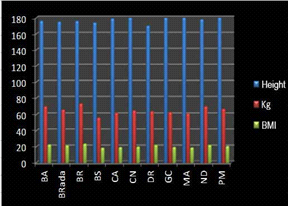
Values determined from somatometry show that squad is heterogeneous with height not fall into the
somatic pattern of international volleyball players proposed by Romanian Volleyball Federation:
centers female players must be over 185 cm, setters over 174-176 and extremes higher than the latter.
Weight is quite high, considering that the optimum weight for performance volleyball players results
from taking of 10 units from the number of centimetres that pass over a meter in the height of the
athlete, even if BMI is normal for the population being considered unsportsmanlike (Cordun M., 2009,
pp. 138-139; pp. 90-91).
The values shown in table no.2 and chart no.2 express the unitary power on both feet (PU), on the
right foot (Pud) and left foot (Pus).
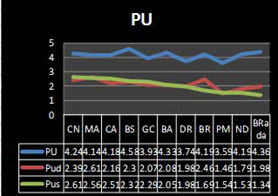
At some players we can notice quite large differences in values between the unitary power
developed on one leg and the other.
Unitary power values express the quality of training and provide athletes the opportunity to
intervene in the optimal dosing of effort by increasing or decreasing series, the number of kg high or
the number of repetitions in the series. It is recommended to test the quality of about 10 workouts. One
single athlete recorded exceptional values. All other fit in average and good qualification, which
expresses a certain lack of control over dosage training.
The value of Hzbor, Hzbord, Hzbors are shown in table and graph nr.3.
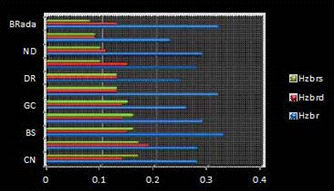
The average height of flight gives information about the repetition speed of the players. Particularly
interesting is the jumping height on both legs, as none of the players use jumping action game based on
one leg.
Hzbor values obtained by each player are significantly related to PU as shown in Table no.4.
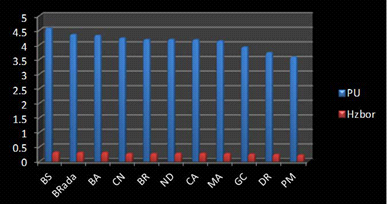
The corresponding values of PU and Hzbor are displayed in descending order. The comparison
between PU and Hzbor demonstrates that high levels of PU corresponds to high values of Hzbor. We
consider that appropriate values of 0.29 to Hzbor are random or express other variables and fit into the
same group 0.28 - 0.29.
Vrep, Vrepd and Vreps values are shown in table no.5 and chart no. 5.
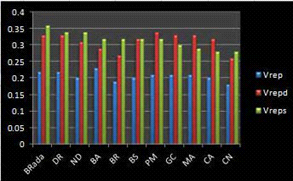
Qualitative analysis from the right side of the table no.5 reveals that the values are very low for the
repetition rate. Two sports have average values but that cannot provide notable performance.
Chart no.5 represent differences between repetition speed on two feet and on one foot. Sports group
is homogeneous, but at a lower level.
Differences in unitary power and power percentage differences are shown in the table no.6 and chart
no.6.
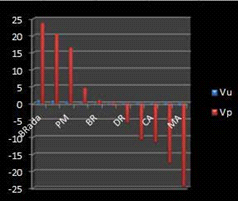
Differences in unitary power expressed both the table and chart show that the preparation of force is
weak for the volleyball players from Division B.
3.Discussion
Preparing lower limb explosive strength ensures high impact point for the spike, block and speed for
short runs and jumping service.
Data analysis shows that athletes are not prepared intensively for explosive power but are not
overused in other respects. From health perspective the medical principle "Primum non nocere" is
respected.
We believe that although the coach has used a recipe adapted to specialists (Bompa, 2003;
Cardinale, 2000), the lack of a benchmark such as lifting maximal value (RM) does not ensure control
and consistency to explosive strength training. Yet the coach is prepared in the future to use the
MGM15 jumping mat as a means of controlling the quality of the training and start a new selection and
accurate recording of individual potential of the players.
4.Conclusions
Unitary power values and the average height of flight show a medium level of training, insufficient
for competitive sports.
Repetition speed recorded low values. To correct this, requires a selection of volleyball player
average equipped in terms of the quality of motor skill - speed. It requires a corroboration of the
repetition speed to personal optimal weight of athletes.
The differences between the unitary power on two feet and the power on the right and left feet
expressed, with one exception, force deficit.
The research proves that the use of the jumping platform MGM15 provides the coach with control
over the effort for the individualization of the explosive force training.
Conflicts of interest
There are no conflicts of interest.
References
- Bompa, O.T. (2003). All about training young champions. Bucureşti: Ed. Ex Ponto, pp. 130-139.
- Cardinale, M. (2000). Strenght training for volleyball: new trends. The coach, The Official FIVB Magazine for Volleyball Coaches, 4, 22-26, December, Lausanne; Cordun, M. (2009). Kinantropometry. Bucureşti: Ed. CD Press. pp. 90-91 Hillerin, P.J. (1999). Proposal for interpretation of the variability of ground contact times and flying in the "MGM-15" test, with indicators of quality of neuromuscular control of the motor type interaction phases. National Conference on Psychology, 27 -29 May, Bucharest.
- Hillerin, P.J. (2009). About the modified Miron Georgescu test 11.14.2012. Retrieved from http//:cursuripjh.wordpress.com; Johnson, D.L., Bahamonde, R. (1996). Power output estimate in university athletes. J Strength and Cond. Res., 10(3), 161-166. Retrieved from http://faculty.fullerton.edu/gnoffal/Courses/561%20Course/ power%20- %20johnson.pdf; Mureşan, A. (2013). The optimization of the explosive force training in volleyball. Sport & Society/Sport si Societate, 13(2).
- Mureşan, A., & Bulduş, C.F. (2013) Volleyball players explosive force evaluation using Jumping mat MGM15. Scientific Report Physical Education And Sport, University of Piteşti, 17(2), 159-165.
- Raţă, G., Grapă, F., Raţă, B.C., Manole, L., Ciocan, D. (2010). Study on the Correlations between the Flight Height and the Two-Legged and One – Legged Take-Off Power in the “Divizion A” Female Volleyball Players. Sport Science Review, XIX(3-4), August 2010. Retrieved from http://www.academia.edu/3172420; *** http://www.frvolei, 2009.
- *** Installation and operating equipment, Carpet jumping Miron Georgescu Type: MGM 15, 2009.
Copyright information

This work is licensed under a Creative Commons Attribution-NonCommercial-NoDerivatives 4.0 International License.
About this article
Publication Date
04 October 2016
Article Doi
eBook ISBN
978-1-80296-014-3
Publisher
Future Academy
Volume
15
Print ISBN (optional)
-
Edition Number
1st Edition
Pages
1-1115
Subjects
Communication, communication studies, social interaction, moral purpose of education, social purpose of education
Cite this article as:
Mureşan, A., Bulduş, C. F., & Grosu, V. (2016). The Control of Explosive Force Training in Volleyball Using MGM 15 Jumping Mat. In A. Sandu, T. Ciulei, & A. Frunza (Eds.), Logos Universality Mentality Education Novelty, vol 15. European Proceedings of Social and Behavioural Sciences (pp. 641-651). Future Academy. https://doi.org/10.15405/epsbs.2016.09.81

